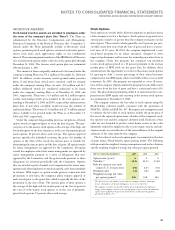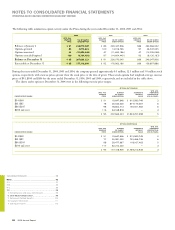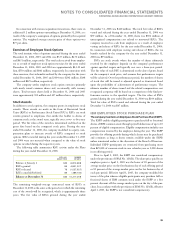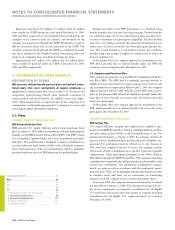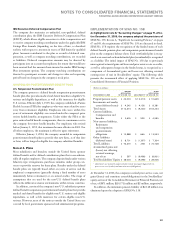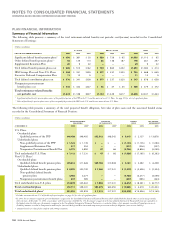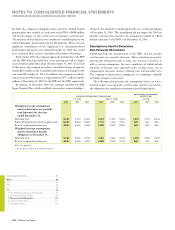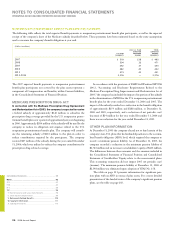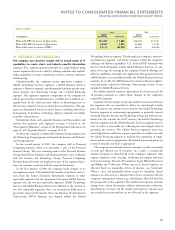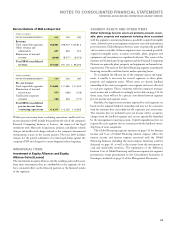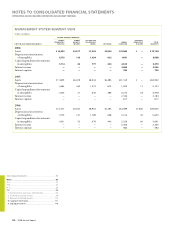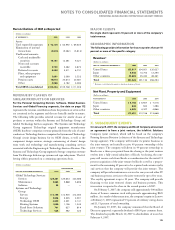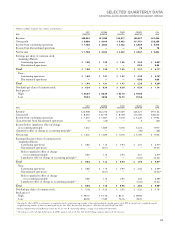IBM 2006 Annual Report Download - page 109
Download and view the complete annual report
Please find page 109 of the 2006 IBM annual report below. You can navigate through the pages in the report by either clicking on the pages listed below, or by using the keyword search tool below to find specific information within the annual report.Black
MAC
390 CG10
DISCOUNT RATE
The discount rate assumptions used for the retirement-related benefit
plans accounting reflect the yields available on high-quality, fixed
income debt instruments. For the U.S. discount rate assumptions, a
portfolio of corporate bonds is constructed with maturities that match
the expected timing of the benefit obligation payments. In the non-
U.S., where markets for high-quality long-term bonds are not generally
as well developed, long-term government bonds are used as a base, to
which a credit spread is added to simulate corporate bond yields at
these maturities in the jurisdiction of each plan, as the benchmark for
developing the respective discount rates.
For the PPP, the changes in discount rate assumptions impacted
both net periodic cost/(income) and the PBO. For purposes of mea-
suring the net periodic cost/(income) for the years ended December
31, 2006, 2005 and 2004, the changes in discount rate assumptions
resulted in an increase in net periodic cost/(income) of $94 million,
$90 million and $197 million, respectively. For purposes of measuring
the PBO, the changes in discount rate assumptions resulted in a
decrease in the PBO of $1,240 million at December 31, 2006 and an
increase in the PBO of $1,272 million at December 31, 2005.
For the significant non-U.S. defined benefit pension plans, the
changes in discount rate assumptions at December 31, 2005 resulted
in an increase in 2006 net periodic cost/(income) of $274 million.
Changes in discount rate assumptions at December 31, 2004 had no
material impact on 2005 net periodic cost/(income).
For the U.S. nonpension postretirement benefit plan, the changes
in discount rate assumptions had no material impact on net periodic
cost/(income) for the years ended December 31, 2006, 2005 and 2004
and on the benefit obligation at December 31, 2006 and 2005.
EXPECTED LONG-TERM RETURNS ON PLAN ASSETS
Expected long-term returns on plan assets take into account long-term
expectations for future returns and investment strategy. These rates of
return are developed by the company in conjunction with external
advisors, are calculated using an arithmetic average and are tested for
reasonableness against the historical return average by asset category,
usually over a 10-year period. The use of expected long-term returns
on plan assets may result in recognized pension income that is greater
or less than the actual returns of those plan assets in any given year.
Over time, however, the expected long-term returns are designed to
approximate the actual long-term returns and therefore result in a
pattern of income and expense recognition that more closely matches
the pattern of the services provided by the employees. Differences
between actual and expected returns are recognized over five years in
the expected return on plan assets line in net periodic cost/(income)
and also as a component of unrecognized gains/losses, which is recog-
nized over the service lives of the employees in the plan, provided
such amounts exceed thresholds which are based upon the obligation
or the value of plan assets, as provided by accounting standards.
For the PPP, the expected long-term return on plan assets of 8.0
percent remained constant for the years ended December 31, 2006
and 2005 and, consequently, had no incremental impact on net peri-
odic cost/(income).
For the material non-U.S. defined benefit pension plans, the
changes in the expected long-term return on plan assets for the years
ended December 31, 2006, 2005 and 2004 resulted in an increase in
the net periodic cost/(income) of $18 million, $140 million and $54
million, respectively.
For the U.S. nonpension postretirement benefit plan, the com-
pany maintains a nominal, highly liquid trust fund balance to ensure
payments are made timely. As a result, for the years ended December
31, 2006, 2005 and 2004, the expected long-term return on plan assets
and the actual return on those assets were not material.
RATE OF COMPENSATION INCREASES
AND MORTALITY RATE
The rate of compensation increases and mortality rates are also signifi-
cant assumptions used in the actuarial model for pension accounting.
The rate of compensation increases is determined by the company,
based upon its long-term plans for such increases. Mortality rate
assumptions are based on life expectancy and death rates for different
types of participants. Mortality rates are periodically updated based on
actual experience. Changes to defined benefit pension plans mortality
rate assumptions increased 2006 net periodic pension cost/(income)
approximately $55 million and changes to the rate of compensation
increases reduced 2006 net periodic pension cost/(income) approxi-
mately $32 million. Changes to the rate of compensation increases or
to mortality rate assumptions had no material impact on the net peri-
odic cost/(income) for the years ended December 31, 2005 and 2004
and on the benefit obligation at December 31, 2006 and 2005.
INTEREST CREDITING RATE
Benefits for certain participants in the PPP are calculated using a cash
balance formula. An assumption underlying this formula is an interest
crediting rate, which impacts both net periodic cost/(income) and the
PBO. This assumption provides a basis for projecting the expected
interest rate that participants will earn on the benefits that they are
expected to receive in the following year and are based on the average
from August to October of the one-year U.S. Treasury Constant
Maturity yield plus one percent.
For the PPP, the change in the interest crediting rate to 5.0 per-
cent for the year ended December 31, 2006 from 3.1 percent for the
year ended December 31, 2005 resulted in an increase to net periodic
cost/(income) of $170 million. The change in the interest crediting
rate to 3.1 percent for the year ended December 31, 2005 from 2.3
percent for the year ended December 31, 2004, resulted in an increase
to net periodic cost/(income) of $55 million. The change in the inter-
est crediting rate to 2.3 percent for the year ended December 31,
2004 from 2.7 percent for the year ended December 31, 2003, resulted
in a decrease to net periodic cost/(income) of $20 million.
NOTES TO CONSOLIDATED FINANCIAL STATEMENTS
INTERNATIONAL BUSINESS MACHINES CORPORATION AND SUBSIDIARY COMPANIES
107


